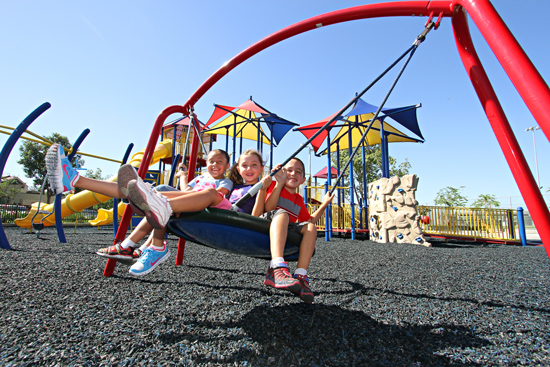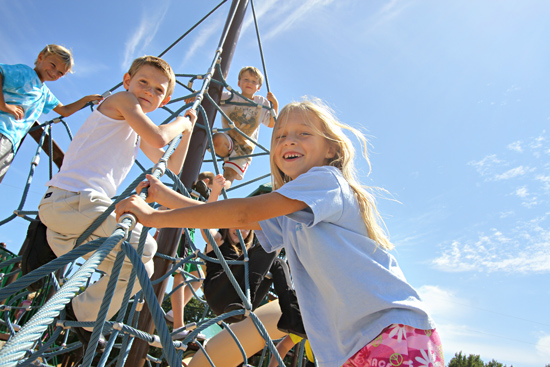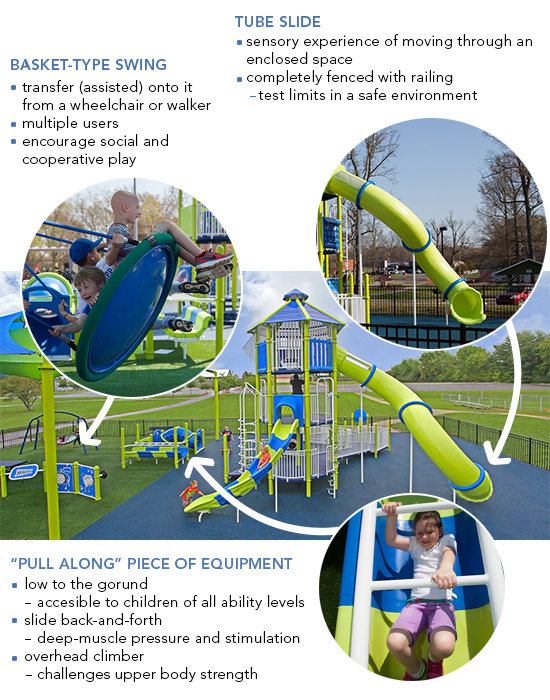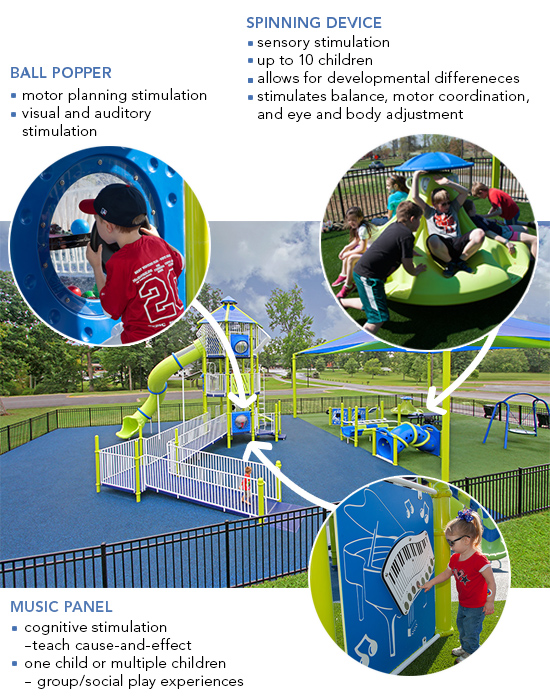How to Design Playgrounds for Optimal Sensory Development
Playground Design 101 for the Architect of Landscape Architect
Few design endeavors can bring more impactful, positive results than a playground project. The skills children develop on a playground can improve their entire lives. We’ll discuss the specific types of equipment that bring about the benefits we have discussed, but first, here are the basics for designing superior playgrounds.
Site integration: Where possible, allowing the playground to interact with its natural surroundings offers all children the opportunity to engage their senses, as they wish, with irregular shapes, the sound of wind and birds in the trees, the smell of spring flowers, and the sight of fall foliage.
Preserving vegetation in its place also creates wind, sound, and weather breaks, and can define the play area boundaries.
While the playground should be clearly distinguished from its surrounding environment, those boundary elements should not create barriers. Various types of routes, like steps and ramps, allow easy access without limitations.
Layout: If space allows, dividing a play area into one with equipment targeted for 2- to 5-year-olds and another aimed at 5- to 12-year-olds, with a few common areas in between, guarantees a more challenging and exciting experience for older children with an inviting, approachable play area for the youngest playground visitors.
Accessible areas that are isolated from the main space do not communicate inclusivity or interaction. Specific therapeutic activities should be located in the middle of a play area, or interspersed throughout, to truly engage all the children. These pieces should be located within a certain radius of where the action is to encourage engagement. Parallel play spaces are key.
Variety: Children enjoy variety in their playground equipment and space. The best design will allow for adaptive and inclusive play that shifts with children’s interests and abilities.
Imagine the types of activities that may go on there: physical games, creative games, social games, games that engage the senses, and areas for those children who may wish to play in peace and quiet. Inclusive sensory design will incorporate variety.
Ideally, there will be a mix of equipment, a mix of social and more private spaces, and a mix of equipment for children of various ages and abilities.
Quiet spaces: It is very important to have quiet or resting areas in which children can regroup, but where they don’t have to leave the playground completely.
Simple strategies can carve out quiet spaces in the midst of gathering spaces. Allowing a break space or a space for a child to retreat to is especially valuable for children with sensory processing disorders (SPD). These children particularly can be touch and sound sensitive, and may find a squeaky swing or clanging stair to be overwhelming. Spaces that allow for solitude or escape within the playground mean that a child can take his or her break, and yet remain within the social space.
Anything that provides a shield from stimuli for the child away from the crowd, sound, sun, or noise can act as a quiet space. This could be a tunnel, a shaded bench under a play tower, or perhaps a cozy nook beside a slide. Creating quiet spaces allows children to actively change their involvement at their own discretion.
Caregivers: The needs of caregivers must be considered as well. Benches, ramps, and large equipment invite adults not only to observe, but also to participate easily. Allowing caregivers a place to be close at hand, yet to allow children to explore and interact as independently as possible, is increasingly important in our highly protective world, where children have fewer and fewer opportunities to problem solve and create on their own.
Specifying Equipment to Foster Sensory Development
When children run, walk, or roll excitedly onto a playground, they do not think: “Here is an opportunity to develop all of my senses.” All they see is an opportunity for play and fun. But a savvy designer will specify playground equipment that will not only provide playful fun required, but assist children in sensory development that will have lifelong benefits. Here are some types of playground equipment and their benefits.
Swinging Equipment
Swinging provides both vestibular and proprioceptive inputs. Balance, eye movement, and body position are a big part of the activity. On the playground, children learn to recognize how their movements affect the speed at which they swing, the timing of the activity, as well as where the body goes as a result of these movements.
Equipment examples: Swing set, tire swing, multi-user swing, and parent/child swing.

Swinging is more than just fun. It engages the child’s vestibular, proprioceptive, and visual senses, and develops the child’s ability to balance and awareness of body positioning.
Spinning Equipment
Spinning involves balancing and body positioning while engaging the child’s vestibular, proprioceptive, and visual senses.
Equipment examples: Merry-go-round, pole with standing base, and seated spinner.
Sliding Equipment
Sliding provides children with sensations of movement and speed without requiring any a great deal of additional effort. Sliding down the slide offers vestibular input because of movement, while the hard or textured surface of the slide can provide both tactile and proprioceptive input. Different types of slides provide a variety of sensations, including those brought on by twists, waves, and different textures. Incorporating slides with multiple bed-ways and climbers helps children develop physical skills and muscle tone, along with cognitive skills, such as problem solving and memory, by visualizing where and how to position their bodies.
Equipment examples: Roller slide, spiral slide, and tube slides.
Climbing Equipment
Climbing and its related activities help to develop the vestibular and proprioceptive inputs, improving muscle tone and balance.
Fine motor skills and gross motor skills are developed simultaneously when traversing climbing walls.
Incorporating climbing equipment helps children enhance their spatial awareness, coordination, and body management skills by offering a variety of different types climbing challenges.
Equipment examples: Rope tower, rock wall, and ladder climber.

Specifying climbing equipment not only provides a fun challenge on the playground, but it also gives children a chance to enhance their spatial awareness, coordination, and body management skills.
Rocking Equipment
Rocking stimulates the vestibular and proprioceptive systems, while also helping to develop muscle tone. The rocking motion helps establish a sense of timing that is stimulating for a child’s sensory system.
Equipment examples: Teeter-totter and spring riders.
Crawling Equipment
Crawling helps to develop balance, strengthen muscle tone, and develop eye-hand coordination. The crawling movement is repetitive, and this stimulates brain activity to develop cognitive processes, such as concentration, memory, comprehension, and attention.v
Equipment examples: Climbing tunnel and crawl tube.
Balancing Equipment
Balance uses both vestibular and proprioceptive inputs along with visual and motor skills. Balance and coordination help children gain awareness of their own bodies by supporting the development of gross motor skills. This type of equipment also supports children’s awareness of their center of gravity and equilibrium, essential for physical skills. On the playground, children use their sense of balance to maneuver, while developing muscle tone and using problem-solving skills.
Equipment examples: Stepping pods and balance beam.
Bouncing Equipment
Bouncing offers vestibular and proprioceptive inputs along with the use of gross motor skills. The stimulating and repetitive motion provides an exhilarating experience for children.
Equipment examples: Stationary pogo stick with spring and standing platform, and stand-up teeter-totter with handle bars.
Auditory Equipment
The ability of children to make sounds from playground equipment aids in the development of their auditory sense.
Equipment examples: Activity panels and outdoor musical instruments.
Conclusion
To a child, a playground looks like fun. But it can be so much more than that. Thanks to the integration of wisdom from child development experts, equipment manufacturers, and landscape architects, playgrounds can provide vital experiences that foster sensory development. These developed senses make it easier for children to move around in the world, to communicate, to get along with others, and to have a sense of self and self-confidence. Opportunities for sensory development are even more important for children with physical limitations and those who have sensory processing disorders. With knowledge gained from this article, the architect, landscape architect, or designer can ensure that a playground is not only fun, but also a safe, energizing place for children to develop, with lifelong physical, cognitive, emotional, and social benefits.











